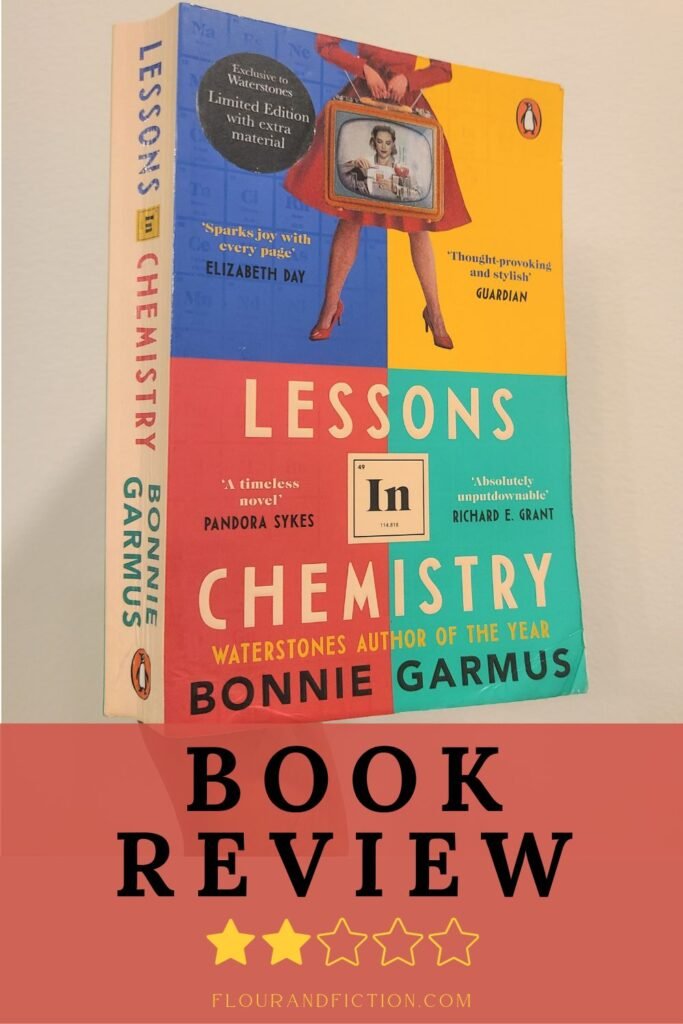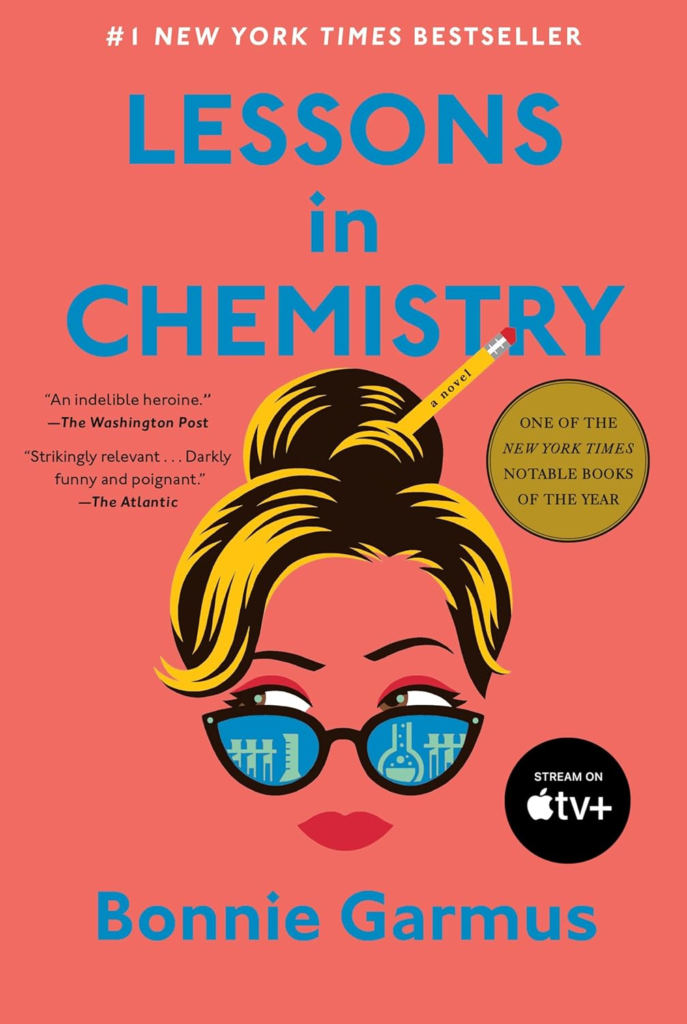Lessons in Chemistry by Bonnie Garmus takes us back to the 1960’s, where Chemist, Elizabeth Zott, struggles to gain respect, be taken seriously, and generally do her work and get credit for it at her all-male research institute. Those of us who work in male-dominated fields are already tired. We know the struggle all too well. Maybe skip this book if the first line left you feeling triggered.
My book club read Lessons in Chemistry a few months ago, and it is a #1 New York Times Bestseller…but we all are wondering WHY. It also won the Goodreads Choice Award for Best Debut Novel in 2022.
Other than inspiring me to write about the Chemistry of Baking, I didn’t like this book very much. I know it’s an unpopular opinion, but this is going to be one of the few negative reviews for Lessons in Chemistry out there.
My Rating for Lessons in Chemistry

Lessons in Chemistry gained a ton of popularity with women and now has become a show on Apple TV. The US cover below makes it look like a total book club book. But my book clubbers were not fans!
It’s definitely a book with a strong female protagonist, which I usually enjoy. However, the protagonist here was strong in a really flat and predictable way. I gave Lessons in Chemistry 2 stars because the characters and their decisions were not very nuanced or believable to me. Though perhaps believable for the time period, there was also a misplaced magical realism element that makes me wonder whether the whole book is meant to be a fantasy.
CW: Lessons in Chemistry is not spicy. It may not be suitable for everyone, as there is a sexual assault in the first few chapters. You can skip this without missing out on the core of the book.

Synopsis
Lessons in Chemistry takes us back to the 1960’s, where Chemist, Elizabeth Zott, struggles to gain respect, be taken seriously, and generally do her work and get credit for it at her all-male research institute.
After being forced to resign, Elizabeth must take a job she doesn’t prefer just to support her family. She is hired as a TV chef and host of the show Supper at Six. The only problem is – she’s not a TV personality…she’s a chemist.
Instead of following her producer’s directions to smile and dress pleasantly, Elizabeth uses her platform to teach chemistry and wear PANTS. To her network’s chagrin, her audience is loving these antics! They feel seen, they are learning, and above all, Supper at Six provides them the thing their husbands don’t — appreciation for their work. Elizabeth ends up revolutionizing dinnertime by bringing scientific cooking instruction and feminist commentary to the lives of housewives across the nation.
My Take on Lessons in Chemistry
Spoiler alert!!!
I enjoyed the first third of this book before Calvin died. Unfortunately, I found it more interesting to read about the love story between Elizabeth and Calvin than it was to read about her life in general. The author set the scene well, when describing the research lab and some of the early challenges Elizabeth went through at work.
I did appreciate some of the struggles Elizabeth went through being a researcher, as they mirrored some of the experiences my friends have had working in academia. The fact that Elizabeth doesn’t want to marry Calvin because it would mean a loss of her name and that Calvin’s name and reputation would henceforth overwrite her work, is one example.
However, some of the situations seemed over the top – almost like the author tried to throw every possible struggle in there to make sure it was very clear that Elizabeth’s life was HARD. I did not grow up in the 1960’s, so some of the misogyny seems unbelievable to me.
- Elizabeth is essentially fired or forced to resign because she became pregnant out of wedlock
- Miss Frask, the mean personnel employee, gets fired for gaining two pounds
- Anytime Elizabeth does anything, it’s met with a gasp and an exclamation – “a woman!?”
Would this have really happened in this time period? Leave a comment if you have any insight. Maybe it was realistic for the time, and misogyny has just gotten more subtle as of late.
Nice Try, But in the End…
I liked the way Elizabeth took a situation that was totally the opposite of what she wanted, and made it her own. The traditional 1960’s housewife was the foil to her entire persona. So, when Elizabeth had to take the job on Supper at Six, it was nice to see how she transformed the show into her own creation, changing the set, the costumes, and the script to suit her. Not to mention, she ends up helping people in the process.
Elizabeth spends her whole life trying to make a name for herself in her industry and avoid riding Calvin’s coattails. In the end, she finds out that her big donor – the only reason she gets to work on her own research – is Calvin’s mom. It almost nullifies all her work because in the end, all her success is still due to Calvin.
Critique of Lessons in Chemistry
Six-Thirty
At first I thought Six-thirty, the talking dog, was kind of cute and found his thoughts to be endearing. Then it got old. The dog also is responsible for taking Mad, Elizabeth’s daughter, to school and picking her up afterwards. Why was there even a talking dog to begin with? This isn’t a fantasy novel.
Rowing
Why the obsession with rowing? It seemed to be irrelevant, yet took up so much space in the story. Perhaps it was a way to try to bring some dimension to a very flat character, by giving Elizabeth some identity other than being a chemist. In the end, when I read the author’s bio, I learned that the author is a rower. Now, I think it’s just something Garmus threw in there because it’s her hobby.
Elizabeth & Madeline “Mad” Zott
When Elizabeth’s daughter, Mad, is born, she turns out to be just like her mother – an archetype with no complexity. She is incredibly talented, well-behaved, and intelligent beyond her years. She’s listening to Darwin’s On the Origin of Species as a toddler, has sixth grade math skills at the age of five, and has inherited her mother’s matter-of-factness and inability to read social situations. When Harriet, the neighbor, suggest they make mud pies, Mad writes 3.1415 in the dirt.
What else would one expect of the child incubated while her mother converts their kitchen into a chemistry lab? It’s frustrating that the author seems to say that a strong female lead cannot coexist with a kitchen – as if cooking is the antithesis to feminism. Or that you have to excel in unrealistic ways to be a strong female character. Thankfully, feminism has become more nuanced since the 60’s.
Even the way Mad gets her name is somewhat ridiculous. After her delivery, a nurse walks into the hospital room with a stack of paperwork, asking questions. Elizabeth thinks the nurse is asking how she feels.
“Mad.”
“Mad?” the nurse had asked.
“Yes, mad,” Elizabeth had answered. Because she was.
“Are you sure?” the nurse had asked.
“Of course I’m sure!”
-“Lessons in Chemistry -“, Bonnie Garmus
And the nurse proceeds to write “Mad” down on the baby’s birth certificate. Eye roll.
Time Travel
All the characters acted like they were from 2023 and time travelled back to the 1960’s. Their mindset’s were more modern, but their circumstances were from the past. Elizabeth is appalled that people treat her differently as a woman in her research institute. I imagine that someone who grew up in the 60’s would have some sort of expectations on how women might be treated in the workplace.
Elizabeth is also shocked at the wave of negative reactions she gets after her big TV announcement that she is an atheist. Again, this seems like it wouldn’t be shocking to someone who lived in that time period.
Conclusion
Filled with some questionable situations and textbook feminism, Lessons in Chemistry gets 2 stars because it just wasn’t very nuanced. The characters were archetypes and the ending was disappointing.
While some of Elizabeth’s struggle were relatable, my book club and I found most of the book to be unrealistic. I wonder if this book would’ve landed a bit better with someone who was alive in the 60’s. It might not be a bad book; perhaps it was just intended for an older audience.
I was encouraged by the fact that this is the author, Bonnie Garmus’ debut novel, published at the age of 65. It gives me hope that I still have time to write my own novel!


2 responses to “Lessons in Chemistry by Bonnie Garmus | Book Review”
Yes she absolutely could have been fired for being pregnant. Or even if she got married. The army used to make women choose between keeping their job or getting an abortion of pregnant. Women couldn’t open bank accounts or get credit cards without a male cosigner. Look up all the rights we didny have before RBG, Gloria Steinem, and other womens rights activists finally gained in the 70s, 80s and even 1990s.
Thanks for sharing! I’ve heard about the credit card restrictions. Did you think the rest of the book felt realistic for the time period?